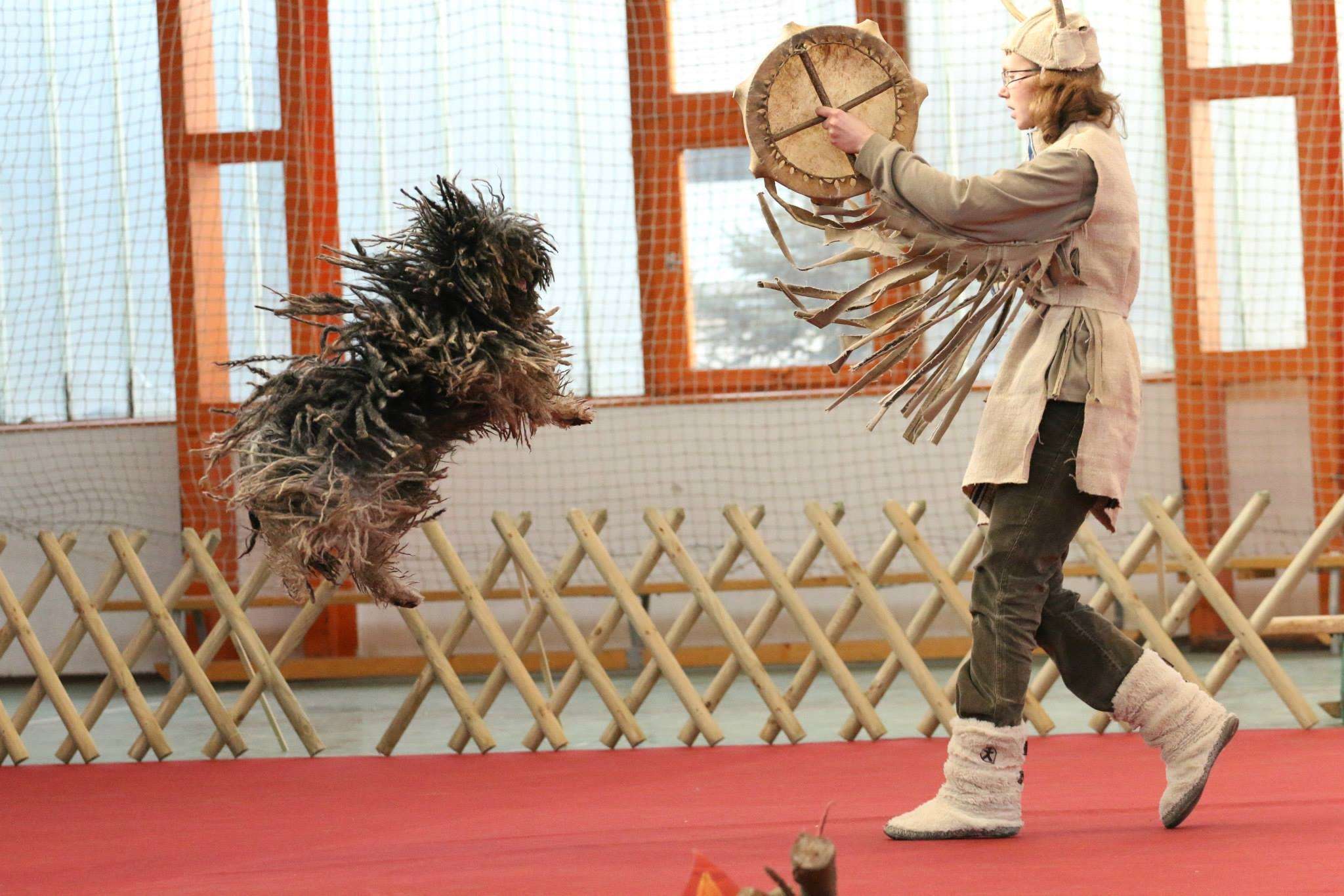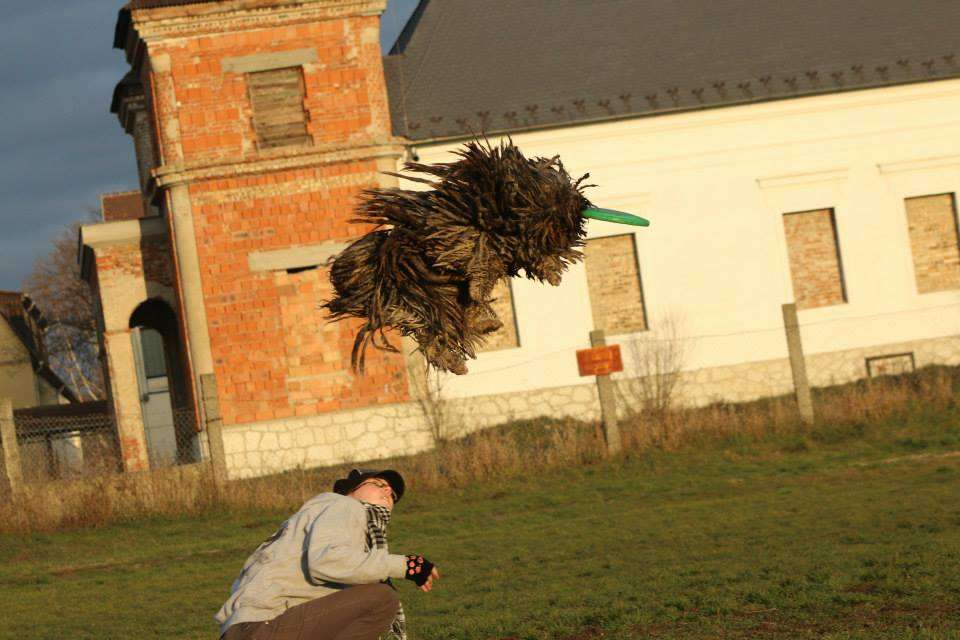Dog Sports with Pulik
Dog dancing:
Dog dancing is a young dog sport that combines obedience and agility exercises with tricks, performed by a dog and its handler to a chosen or randomly selected piece of music, presented in a freestyle routine. According to some sources, the creators of this sport are Dawn Jecs and Mary Ray, who were the first to publicly demonstrate such a performance. In Hungary, the world became acquainted with the high-quality routines of Hungarian-born competitor Attila Szkukalek, who lives in England. The performance is judged by a panel of judges, similar to figure skating, considering both the artistic and technical execution. Within dog dancing, there are official and hobby classes, and the sport is divided into two divisions: Freestyle (FS) and Heelwork to Music (HTM). In hobby classes, the use of motivational tools (such as treats or toys) and aids is allowed, and pairs receive verbal or written feedback, but no ranking, only constructive criticism. In official classes, the use of primary and secondary motivational tools is not allowed. The Freestyle routine is free-form, with no specific elements required; handlers are free to choose their movements. In contrast, the Heelwork routine requires the choreography to consist of 75% predetermined positions, with the remaining 25% involving transitions between those positions, which may include freestyle elements. The music duration typically ranges from 1.5 minutes to 4 minutes, depending on the class.
The official class groups in both FS (Freestyle) and HTM (Heelwork to Music) are as follows:
Class 1
Class 2
Class 3
Senior and Handicap Class (For dogs over 8 years old or dogs with disabilities)
Junior Class (For young handlers up to 16 years old)
Trio Class (1 handler with 2 dogs)
Quartet Class (2 handlers with 2 dogs)

This sport requires great concentration and harmony from both the Puli and its owner. The breed is famous for closely watching every move its owner makes, with an unparalleled desire to please and a strong inclination to be obedient. In this sport, the Puli can rightfully showcase these wonderful traits, as well as its active and temperamental personality, sporty, flexible, and agile body structure. Its ability to learn and intelligence are crucial for mastering tricks, tasks, and exercises. Its unique appearance and visually striking coat make the joint performance even more enjoyable and spectacular. The Puli loves being close to its owner, so learning the HTM positions isn't a major challenge, as seeking eye contact is in its nature. However, a drawback is the talkative nature of the Puli, which unfortunately results in point deductions due to vocalization.
This dog sport is also a perfect choice, as the most important thing for a Puli is to be with its owner. The shared task and activity are the real reward for the Puli.
Agility
The meaning of the word agility is: nimbleness, speed, dexterity.
akadályok sorrendjét és szintidőhöz kötötték a pálya lefutását. A ChatGPT ezt mondta: ChatGPT The history of agility is attributed to Peter Meanwell and dates back to 1978. He was tasked with organizing a demonstration to promote a dog show. A lover of both dogs and horses, he created a course based on elements taken from dressage, which the dogs had to complete in a specific order under the guidance of their owners. Following the great success of the event, the obstacle elements were expanded, the sequence of the obstacles was changed, and the course completion was timed.
The courses typically consist of 15-20 elements, with the order and time limit depending on the specific course. The obstacles can include: jumping obstacles, long jumps, hoops, tunnels, tables, slalom, crawl tunnels, sack crawls, and zone obstacles (such as ramps, seesaws, and planks).
In terms of classification, there are two categories within the sport: Agility and Jumping. The Agility category includes zone obstacles, while Jumping courses do not feature these elements. The classification consists of official and hobby categories:
Beginner class (non-official category)
A1 Class
A2 Class
A3 Class
Veteran class (non-official category)
Depending on size, dogs can compete in three categories:
Mini (under 35 cm at the withers)
Midi (between 35-43 cm at the withers)
Maxi (above 43 cm at the withers)

An excellent dog sport that develops and strengthens the bond between the Puli and its owner, helps to release excess energy, and is both physically and mentally tiring. Metacommunication and the use of body language alongside words and commands are very important. The Puli is highly attuned to every word of its owner, understanding even the smallest of gestures, which is crucial on the course, as even a single mistake, such as jumping an obstacle in the wrong direction, could result in disqualification. The Puli’s agility, flexibility, and speed make it perfect for this sport. The only drawback might be its thick coat, which can accidentally knock down obstacles. However, this can easily be addressed with a more athletic haircut.
Frisbee
In 1974, Alex Stein and his dog, Ashley, were the first to attempt a spectacular demonstration by catching flying discs. During the halftime of an American football game, he managed to get past the barriers and started throwing discs to his dog in the middle of the field, which was met with great enthusiasm by the spectators. After this, the sport gained more and more popularity, and more and more people began throwing discs.
Different regulations (UFO, USDDN, Skyhoundz) define the various classes, their descriptions, and evaluations.
A few selected classes: Distance events (D-Tour, Throw and Catch), Quadruped, and Freestyle classes.
Disc catching, throw distance, and throwing technique are all crucial factors in each event.

Here, the Puli's retrieving skills, motivation, and playfulness are very important, as well as its speed and agility, which play a significant role.
Obedience:
Obedience is a highly skilled dog sport that is recognized worldwide. It involves various obedience tasks and exercises, such as: heelwork, walking on a leash, group stays, down stays while moving, recall, sendaways, retrieving, etc. There are four levels in the competitions: Beginner, Level 1, Level 2, and Level 3.
The Puli doesn't "need to be taught" because it is always by its owner's side... Here too, the Puli's desire to please and its obedience are advantageous, as it always wants to make its owner happy. Whatever task is asked of it, the Puli will try to accomplish it because its owner's happiness is the most important thing to it.
They can excel in almost every dog sport! The most important thing is the time spent together, the shared activities, the physical exercise, and the mental and physical work.
Orsolya Buha

Regulations
- Regulations
- Privacy Policy
- Articles of Association
- Ethics and Disciplinary Regulations
- Report
- Legal Notice, copyright information.
Follow us
puli.hu is an amazing website! Filled with wonderful pictures of Pulik, entertaining videos, and interesting content that will make every Puli fan's heart race.
Kiss Anna
© 2024 | All rights reserved | puli.hu | Powered by: MLZA.